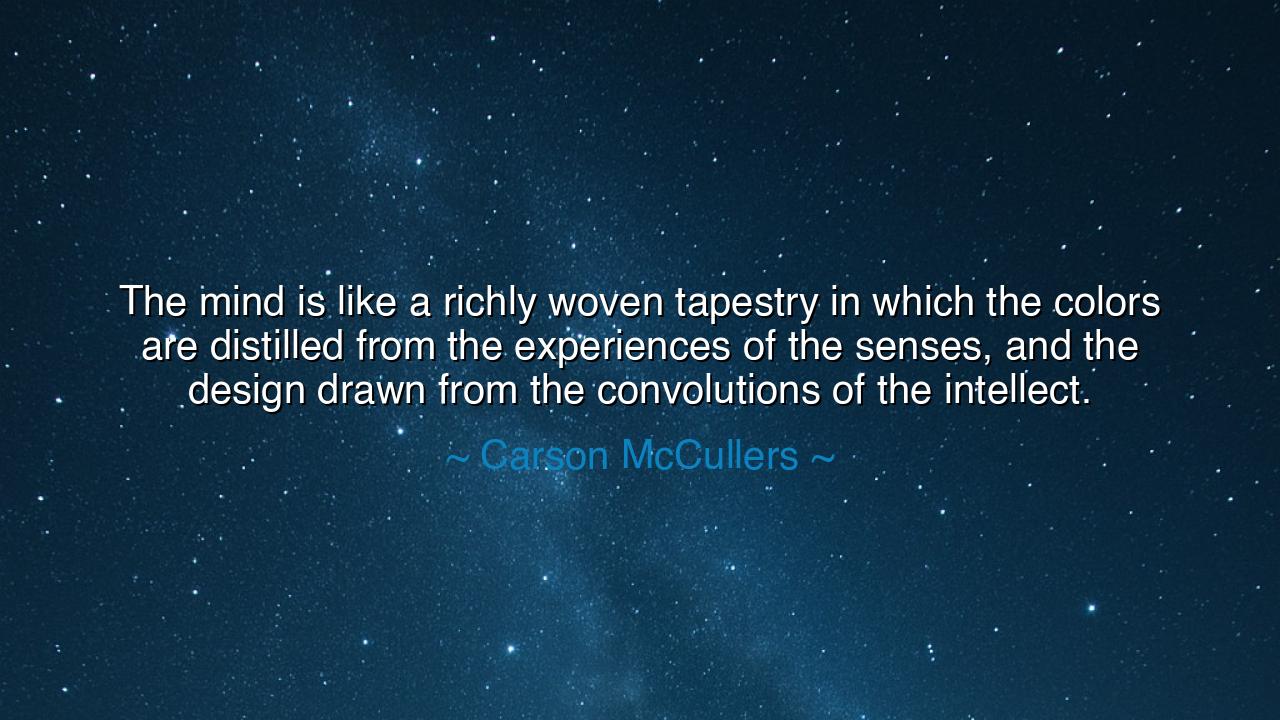
The mind is like a richly woven tapestry in which the colors are
The mind is like a richly woven tapestry in which the colors are distilled from the experiences of the senses, and the design drawn from the convolutions of the intellect.






“The mind is like a richly woven tapestry in which the colors are distilled from the experiences of the senses, and the design drawn from the convolutions of the intellect.” — Carson McCullers
Thus spoke Carson McCullers, the Southern seer of the human soul, whose words shimmer with both mystery and truth. In this reflection, she likens the mind to a tapestry — a grand weaving of memory, perception, and thought, crafted thread by thread through the course of one’s life. Her metaphor is not only poetic but profoundly philosophical: for in the tapestry of the mind, color and design are born of two forces — the senses, which bring the raw materials of experience, and the intellect, which gives them form, pattern, and meaning. McCullers invites us to see thought not as a cold mechanism, but as art — the most intricate creation of all, formed by the loom of life itself.
The origin of this insight lies in McCullers’ deep sensitivity to the complexity of human nature. Born in the American South in the early twentieth century, she lived a life marked by observation, illness, and introspection. Her novels — like The Heart Is a Lonely Hunter — reveal minds brimming with color and contradiction, woven from sorrow, wonder, and the yearning to understand. Her description of the mind as a tapestry reflects her belief that no thought exists in isolation. Every emotion, every sound, every sight absorbed by the senses adds a thread to the grand design. The intellect — that divine craftsman within — takes these fragments and binds them into a picture that becomes the self.
When she speaks of “colors distilled from the experiences of the senses,” she honors the sacred role of perception. To live, truly live, is to see and to feel — to take in the world through sight, sound, taste, touch, and smell, and to let those sensations seep into the soul. The scent of rain, the pain of loss, the laughter of a friend — these are the dyes from which the mind’s colors are drawn. Yet without intellect, those colors remain unformed, scattered, chaotic. It is the mind’s deeper power — reflection, imagination, interpretation — that shapes them into design. The senses feed the soul, but the intellect gives it voice.
Consider, as an example, the life of Leonardo da Vinci, the Renaissance master whose mind was itself a living tapestry of wonder. He observed the curve of a leaf, the flight of a bird, the shimmer of light on water — each sense absorbing the world in perfect detail. But it was his intellect, his unquenchable curiosity and capacity for synthesis, that drew those threads together into the designs of art, science, and invention. Leonardo’s genius was not born of intellect alone, nor of sensation alone — it arose from the fusion of both, from the way his senses painted and his intellect composed. In him, as in McCullers’ vision, the tapestry of the mind reached its most luminous form.
Her teaching also bears a warning to the modern age. For in our haste to analyze, to measure, to categorize, we risk forgetting the art of seeing and feeling. A mind deprived of sensation becomes pale, abstract, lifeless — while a life ruled only by sensation, without reflection, becomes chaotic and shallow. The balance of color and design, of experience and understanding, is what gives the human spirit its richness. To live wisely, McCullers tells us, we must not only think deeply but feel fully — and to feel fully, we must open our senses to the world.
This quote, though tender in its imagery, is heroic in its truth. For every mind is a masterpiece in progress, a work that grows more complex with each encounter and each reflection. No two tapestries are the same; each bears its own pattern of memory and meaning. Even pain, when seen with wisdom, becomes a thread of darker hue that gives depth to the whole. The wise do not seek to escape suffering, but to weave it into understanding, transforming it into beauty through the patience of the intellect.
So, O seekers of knowledge and truth, heed this lesson: attend to your senses, and cultivate your mind. Let every sound, every color, every sorrow and joy be gathered into your loom. Reflect upon them, shape them, give them meaning. The world is not outside of you — it is woven within you, strand by strand. The task of your life is not to flee from it, but to create from it something magnificent. For as Carson McCullers teaches, the mind is not merely a vessel of thought — it is the living tapestry of existence itself, rich with the colors of experience and the design of wisdom.
And when your days are done, may your tapestry be vast and vibrant — a testament not only to what you knew, but to how deeply you saw, felt, and understood the world.






AAdministratorAdministrator
Welcome, honored guests. Please leave a comment, we will respond soon